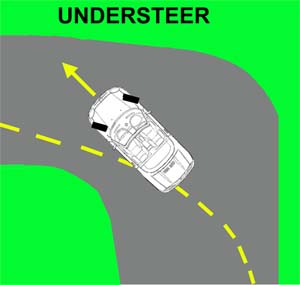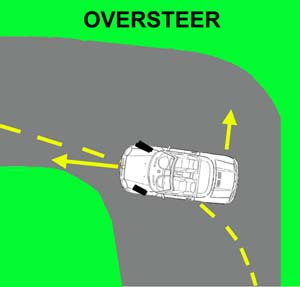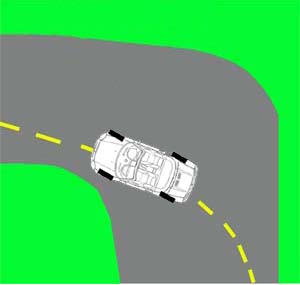
 |
Suspension Geometry/ Tracking |
Introduction
Suspension and tracking settings are fundamental to the way that your car handles and feels on the road. Altering the settings either intentionally or through lack of maintenance will have a profound impact on your car. The objective of this web page is to help provide some insight of the workings and the impact of suspension geometry.
| Definition of the commonly used suspension terms can be found under these headings: | camber | toe | caster |
| King pin/ steering inclination | Tyre slip angle |
Only one geometry variable is truly adjustable on an MGF- the toe angle. Other angles can be altered only throught the modification of the ride (trim) height, achievable alteration of Hydragas pressurisation. Ride height has a knock-on effect primarily upon camber- as explained on the camber page.
|
For the safest handling characteristics as defined by MG, then use the tracking specifications specified by the manufacturer. It is highly advisable on a hard driven road car to get the tracking at least checked once a year. My car usually gets checked far more often than that! Tracking checks need not be expensive- budget about 40-50 GBP- and are certainly worth while to avoid premature tyre wear and keep the car handling to the highest order. Click here for the standard tracking specifications. |
Suspension geometry (tracking)
Before any modification is made to the standard geometry, one should try to understand how the suspension works, why Rover set the car up the way they did, and how modifying the settings alters the handling characteristics of the car.
Definitions:
| Understeer | When cornering, understeer
describes the front of the car scrubbing wide of your desired line, and thus the need to
wind on more steering lock that would be anticipated for a given directional change. Another way to describe this phenomena is in terms of tyre slip angle. Understeer occurs when the slip angle of the front tyres exceeds that at the rear. |
 |
| Oversteer | When cornering, oversteer
describes more directional change than anticipated from a given change of steering lock.
The rear of the car steps out of line and the front of the car turns in more than the
anticipated. Unlike understeer where one applies more lock to compensate, steering lock
needs to be unwound in oversteer- effectively one needs to 'steer into the skid'. In terms of slip angle, oversteer is said to occur when the slip angle of the rear tyres exceeds that at the front. |
 |
| Useful sites describing understeer and oversteer: | Oversteer & Understeer | |
Toe angle and chassis dynamics
As toe angle is the only adjustable facet of the MGF's suspension, we shall concentrate upon how toe-angles alter under circumstances of normal driving, and then on how altering the standard static tracking settings will alter the handling feel of the car.
Influence of bush compliance upon toe- angles
Toe angles change all the time...
An important thing to remember is that the road wheels are not rigidly attached to the car. In a road car suspension system, there are a considerable quantity of rubber bushes designed to reduce road harshness being transmitted directly to the occupants. As these components are flexible, the whole suspension unit consisting of wheels, suspension arms (wishbones etc) track/ steering arms move relative to one another. The up shot of this is that the direction that the wheels point in can change under circumstances of suspension load.
In addition to these flexible component related movement of the suspension, suspension systems are often designed to bring about changes in toe-angle- often to compensate for suspension bush compression, but also to help improve stability under circumstances of heavy acceleration or braking.
The effect of acceleration and braking
| Considerable changes in toe-angle are effected under conditions of acceleration and deceleration by virtue of the flexible suspension components mentioned above. | |
| Let's consider the simple case of the
undriven wheels, set under static conditions with a zero toe-angle (static, in the figure
opposite). The wheels are able to move on their stub axle relative to the rest of the car
via the round pivot on the figure. Let's assume that this pivot point is via the 'king
pin' (the swivel link connecting the upper and lower wishbones). Note: angles are exaggerated for purposes of illustration. |
Static |
| On acceleration, the car moves in the
direction indicated by the green arrow. At the same time there is an opposing force-
indicated by the blue arrow. This is the road resistance being transmitted through the
road wheels. This puts a force on the road wheels that acts about the pivot point. As a
result, the wheels start to point outward- or toe-out. In fact this tendency to toe-out is present under constant running conditions as well as there is always a road resistance. |
Acceleration:
undriven wheels |
| This resistance is radically increased on application of a braking force. The brakes are out board of the pivot point and thus the reaction is greater- the wheels tend to toe-out even further. This is part of the reason why car designers usually design suspension systems with some static toe-in, as this helps compensate for this change of toe-angle. | Deceleration or
braking |
| On the driven wheels the net forces are in the opposing direction under acceleration, and the force reaction to acceleration is in the same direction as the direction of travel. The net result of this is that the driven wheels tend to toe-in. Under constant velocity, forces typically cancel out, so the motive force equals the resistive force, and hence the wheels tend towards their static position. Under deceleration, however, the toe-angle changes are in the same direction as that shown above for the undriven wheels. | Acceleration:
driven wheels |
| The effect of cornering | |
| In cornering, toe-angles are influenced by centripetal forces applied to the road wheels. Centripetal force is where objects tend to want to travel in a straight line, rather than constantly change direction. As a result, when moving in a circle, the object will tend to want to fly off at a tangent to that circle. This is rather like tying a stone to the end of a piece of string, and rotating it above your head. If the string then broke, the stone would fly off in a straight line whose origin would be on the circumference of the circle of rotation. So it is with the road wheels and tyres: they'll tend to point away from the direction of travel - and this applies to both the front and rear. [In fact, this phenomena effects the tyres much more than the wheels - thanks to side-wall and tread pattern flex at the contact patch - this is something that is discussed more in the tyre slip angle section.] This is shown in the figure opposite, where, for illustrative purposes, we've illustrated the car as through it were cornering without turning the steering wheel (a bit like a slot car racer!). Here we can see that the wheels point slightly away from the direction of travel: the outer wheels tending towards toe-out, and the inner wheels towards toe-in. The net result of this are reduced tyre slip angles (towards zero), and as a consequence, less grip. |  |
Influence of Kinematic geometry design
The design of suspension geometry is a massive subject - for which there are plenty of university places out there if you really want to get down to the nitty gritty! Obviously, this is all a little too involved for this web page, so we'll concentrate on that area of kinematic design that influences toe-angles.
The effect of suspension movement: bump/roll steerAs we know, suspension moves up (jounce) and down (bounce) as the car travels over road irregularities and bumps. Suspension also moves as the car corners - the outer suspension being compressed, and the inner de-compressed as the car rolls. These movements in suspension also bring about changes in the toe-angle, effectively allowing the wheels to steer the car almost independently of the driver's steering input. These changes in toe-angle are called bump-steer and roll-steer - effectively describing the same phenomena but occurring under the two separate conditions.
Why does the toe-angle alter with suspension movement?For this, we can 'blame' the action of the steering arm link at the front and the tie-bar link at the rear. If we imagine that the double wishbones of the suspension work as a single suspension arm. It pivots at the subframe and circumscribes an arc the length of the suspension arm. Now we add in our steering link. If it is of a different length, or even if it is mounted significantly higher or lower than our suspension arm, then it'll be circumscribing a different arc over the same changes in suspension height. The figure opposite uses a short steering link in the same plane as our suspension arm. The steering arm circumscribes a much smaller radius than the suspension arm, as a result, as the suspension raises or lowers, it appears shorter when looked down on from above. Result: the front of the wheel is pulled into the centre line of the car whenever the wheel moves from its static position, thus there is a toe-angle change, and the wheel is applying a 'steering force'. If a steering link the same length as our suspension arm is used, but now pivoted below the suspension arm, we can see that when the suspension is decompressed, the wheel will toe-in, and when compressed, the wheel will toe-out. So here we have methods by which toe-angles can be finely tuned according to suspension position.
| Side on | From above | From the front |
 |
||
Now let's look at the MGF bumpsteer characteristics. Here I am using figures kindly sent to be by John Englaro. The measures he took were measures of change of toe-angle as ride height was altered from the nominal standard MG specification ride height (368mm front, 363mm rear), which is set at the zero intercept on the graphs.
First thing to notice is how different the bumpsteer characteristics are on the front versus rear wheels: the slopes are opposite.
Front |
Rear |
|||
wheel: |
Outside |
Inside |
Outside |
Inside |
| STATIC | Out |
In |
||
| Steady state driving | Out |
Neutral |
||
| Cornering | Out |
In |
In |
Out |
Excessive toe-out causes inner tyre edge wear. Excessive negative camber causes inner tyre-edge wear. Look at the summary above, you can that we have a potent recipe for tyre wear that typically afflicts MGFs.
We know that some toe-out is good for initial steering response (this is explained in more detail on the Toe-explanation page). But here we have a lot of parameters (toe) that seem to be pointing in the same direction - which could lead to excessive toe-out, tyre wear, increased tyre slip angles and ultimately less grip at or near the handling limits.
Therefore there may be good grounds for considering altering the standard tracking settings. Let's consider some of these, and how they impact upon the impression of handling (Nickolaj has done something very similar to this as well - see http://www-users.rwth-aachen.de/nikolaj.klingemann/mg-f/fahrwerkseinstellung.htm)
FRONT TOE |
REAR TOE |
IMPRESSION |
Standard -0°10' |
Standard +0°10' |
Steering feel isn't brilliant, nor is steering response. But turn is adequate. Surprising depths of handling reserves - the car really looks after you. |
+0°5' |
0°0' compliance washers fitted |
Good turn-in (helped by the aggressive rear toe-angle), although initial steering response is quite good, steering feel about the straight-ahead is not great. But once into the corner, the steering feel really improves. The rear end though is very prone to oversteer, which really limits cornering velocity. |
+0°5' |
+0°5' compliance washers fitted |
Again, car feels excellent when placed into the corner, albeit with slightly numb feel about the straight-ahead. Turn-in is fine with the rear toe-angle. Rear end now feels much more secure when pressed. Great fun. |
0°0' |
+0°5' compliance washers fitted |
Compromise: better straight ahead steering feel, with perhaps fractionally better turn in, although once into the corner, the car doesn't feel quite as solid. But rear end remains nicely controlled. |
I have never tried rear toe-out - nor would I - the chances of the car suffering from snap-oversteer are too high. Interestingly, this is what Nickolaj found when he tried it briefly on his car as an experiment.
Summary
Overall, I would leave the rear tracking settings well alone: the rear suspension does exactly what it has been designed to do - keeping the car and the driver safe!
The front is a different question. You need to make an informed decision regarding the compromises brought by altering the standard toe-angles. The trade off is straight-line stability (toe-in) against steering feel and response (toe-out). If you have inner edge tyre wear, then perhaps your decision is partly made for you: reduce the toe-out. 0°0' is a good compromise, and is the front tracking value used on the MGTF - although that car has very different rear bumpsteer characteristics to the MGF, which in part is why the static tracking specifications for that car have been altered.